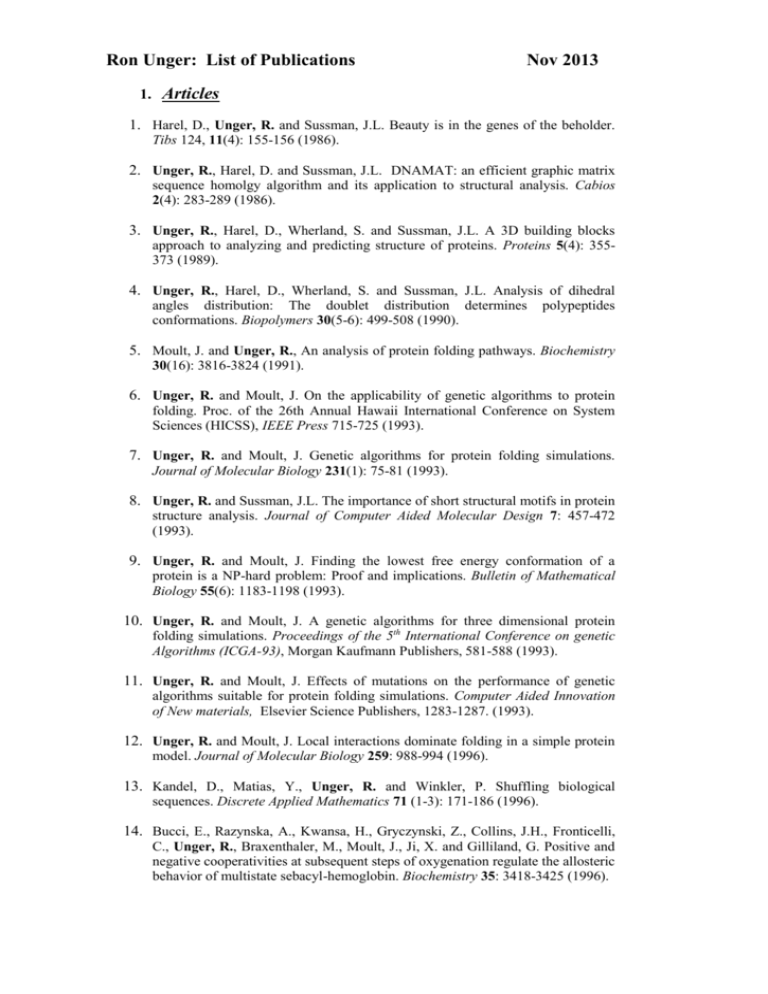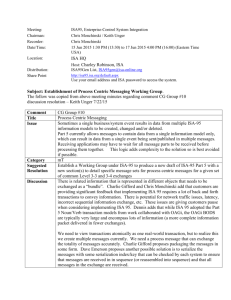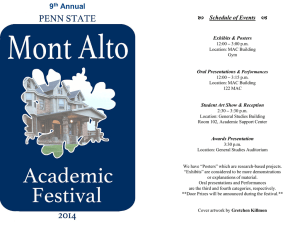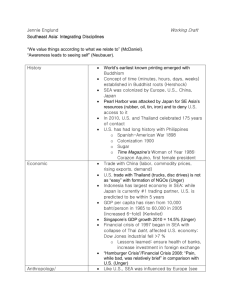Publication list
advertisement

Ron Unger: List of Publications Nov 2013 1. Articles 1. Harel, D., Unger, R. and Sussman, J.L. Beauty is in the genes of the beholder. Tibs 124, 11(4): 155-156 (1986). 2. Unger, R., Harel, D. and Sussman, J.L. DNAMAT: an efficient graphic matrix sequence homolgy algorithm and its application to structural analysis. Cabios 2(4): 283-289 (1986). 3. Unger, R., Harel, D., Wherland, S. and Sussman, J.L. A 3D building blocks approach to analyzing and predicting structure of proteins. Proteins 5(4): 355373 (1989). 4. Unger, R., Harel, D., Wherland, S. and Sussman, J.L. Analysis of dihedral angles distribution: The doublet distribution determines conformations. Biopolymers 30(5-6): 499-508 (1990). polypeptides 5. Moult, J. and Unger, R., An analysis of protein folding pathways. Biochemistry 30(16): 3816-3824 (1991). 6. Unger, R. and Moult, J. On the applicability of genetic algorithms to protein folding. Proc. of the 26th Annual Hawaii International Conference on System Sciences (HICSS), IEEE Press 715-725 (1993). 7. Unger, R. and Moult, J. Genetic algorithms for protein folding simulations. Journal of Molecular Biology 231(1): 75-81 (1993). 8. Unger, R. and Sussman, J.L. The importance of short structural motifs in protein structure analysis. Journal of Computer Aided Molecular Design 7: 457-472 (1993). 9. Unger, R. and Moult, J. Finding the lowest free energy conformation of a protein is a NP-hard problem: Proof and implications. Bulletin of Mathematical Biology 55(6): 1183-1198 (1993). 10. Unger, R. and Moult, J. A genetic algorithms for three dimensional protein folding simulations. Proceedings of the 5th International Conference on genetic Algorithms (ICGA-93), Morgan Kaufmann Publishers, 581-588 (1993). 11. Unger, R. and Moult, J. Effects of mutations on the performance of genetic algorithms suitable for protein folding simulations. Computer Aided Innovation of New materials, Elsevier Science Publishers, 1283-1287. (1993). 12. Unger, R. and Moult, J. Local interactions dominate folding in a simple protein model. Journal of Molecular Biology 259: 988-994 (1996). 13. Kandel, D., Matias, Y., Unger, R. and Winkler, P. Shuffling biological sequences. Discrete Applied Mathematics 71 (1-3): 171-186 (1996). 14. Bucci, E., Razynska, A., Kwansa, H., Gryczynski, Z., Collins, J.H., Fronticelli, C., Unger, R., Braxenthaler, M., Moult, J., Ji, X. and Gilliland, G. Positive and negative cooperativities at subsequent steps of oxygenation regulate the allosteric behavior of multistate sebacyl-hemoglobin. Biochemistry 35: 3418-3425 (1996). 15. Braxenthaler, M., Unger, R., Auerbach, D., Given, G. and Moult, J. Chaos in protein folding dynamics. Protein 29: 417-425 (1997). 16. Prokocimer, M., Unger, R., Rennert, H., Rotter, V. and Rennert, G. Pooled Analysis of P53 Mutations in Hematological Malignancies: A lesson to be learned. Human Mutations 12: 4-18 (1998). 17. Yadgari, J., Amir, A. and Unger, R. Genetic Algorithms for Protein Threading. Proceedings of Int. Con. On Intelligent Systems for Molecular Biology. ISMB98, 193-202, AAAI Press (1998). 18. Kaffe-Abramovich, T. and Unger, R. A Simple Model for Evolution of Protein Towards the Global Minimum of Free Energy. Folding & Design 3: 389-399, (1998). 19. Uliel, S., Fliess, A., Amir, A. and Unger, R. A Simple Algorithm for Detecting Circular Permutations in Proteins. Bioinformatics 15: 930-936 (1999). 20. Albeck, S., Unger, R. and Schreiber, G. Evaluation of Direct and Cooperative Contributions towards the Strength of Buried Hydrogen Bonds and Salt Bridges. Journal of Molecular Biology 298: 503-520, (2000). 21. Yadgari, J., Amir, A. and Unger, R. Genetic Threading. J. Constraints 6: 271292, (2001). 22. Uliel, S, Fliess, A. and Unger, R. Naturally Occurring Circular Permutations in Proteins. Protein Engineering 14: 533-542 (2001). 23. Nudelman, G., Tennenbaum, T., Mehr, R. and Unger, R. PESI - An Intelligent System for Prediction of Enzyme-Substrate Interactions Based on Experimental Constraints. In Silico Biology 2:44 (2002). 24. Fliess A. Motro B. and Unger, R. Swaps in protein sequences. Proteins 48: 377387 (2002). 25. Liu, L., Liang, X.H., Uliel, S., Unger, R., Ullu, E., Michaeli, S. RNA interference of signal-peptide-binding protein SRP54 elicits deleterious effects and protein sorting defects in trypanosomes. Journal of Biological Chemistry 277: 47348-47357 (2002). 26. Unger, R., Uliel, S. and Havlin, S. Scaling Law in Sizes of Protein Sequence Families: From Super-Families to Orphan Genes. Proteins 51: 569-576 (2003). 27. Horesh, Y., Amir, A., Michaeli, S. and Unger, R. A Rapid Method for Detection of Putative RNAi Target Genes in Genomic Data. Bioinformatics 19: 1173-1180 (2003). 28. Uliel, S., Liang, X.H., Unger, R., and Michaeli, S. Small nucleolar RNAs that guide modification in trypanosomatids: repertoire, targets, genome organization, and unique functions. Int. J. Parasitol. 34: 445-454 (2004). 29. Liu, Q., Liang, X.H., Uliel, S., Belahcen, M., Unger, R. and Michaeli, S. Identification and functional characterization of Lsm proteins in Tryapnosoma brucei. J. Biol. Chem. 279:18210-18219. (2004). 30. Horesh, Y., Amir, A, Michaeli, S. and Unger R. RNAMAT: An Efficient Method to Detect Classes of RNA Molecules and their Structural Features. Proceedings of the 26th Annual International Conference of the IEEE Engineering in Medicine and Biology Society. 2: 2869-2872 (2004). 31. Rozenberg, Y. and Unger R. The Made-In-Israel Bioinformatics Portal. Briefings In Bioinformatics. 5:389-390. (2004). SINCE LAST PROMOTION 32. Liang, X.H., Uliel, S., Barth, S. Hury, A., Doniger, T., Unger R. and Michaeli S. A genome-wide analysis of C/D and H/ACA-like small nucleolar RNAs in Trypanosoma brucei reveals trypanosome-specific pattern of rRNA modification. RNA 11(5):619-45. (2005). 33. Horesh, Y. and Unger R. A Bottom-up Clustering Algorithm to Detect ncRNA Molecules with a Common Secondary Structure. Int. J. Bioinformatics Research and App. IJBRA 1:294-302. (2005). 34. Unger, R. and J. Moult. Towards Computing with Proteins, Proteins, 63:53-64. (2006). 35. Horesh Y., Mehr, R., and Unger R, Designing an A* Algorithm for Calculating Edit Distance between Rooted-Unlabeled Trees. J. Comp. Biol. 13:1165-1176 (2006). 36. Jacob, E. and Unger R. A Tale of Two Tails: Why are terminal residues of proteins exposed? Bioinformatics 15:e225-230. (2007). 37. Liang XH, Hury A, Hoze E, Uliel S, Myslyuk I, Apatoff A, Unger R, Michaeli S. A genome-wide analysis of C/D and H/ACA-like small nucleolar RNAs in Leishmania major indicates conservation among trypanosomatids in the repertoire and in their rRNA targets. Eukaryot Cell. 6:361-377. (2007). 38. Jacob, E., Horovitz A, Unger R. Different mechanistic requirements for prokaryotic and eukaryotic chaperonins: a lattice study. Bioinformatics 23:i240248 (2007). 39. Horesh Y, Doniger T, Michaeli S, Unger R. RNAspa: a shortest path approach for comparative prediction of the secondary structure of ncRNA molecules. BMC Bioinformatics. 8:366 (2007). 40. Noivirt O, Unger R, Horovitz A Low folding propensity and high translation efficiency distinguish in vivo substrates of GroEL from other E. coli proteins. Bioinformatics 23:3276-3279. (2007) 41. Barth S, Shalem B, Hury A, Tkacz ID, Xue-hai L, Uliel S, Myslyuk I, Doniger T, Salmon-Divon M, Unger R, Michaeli S. Elucidating the role of C/D snoRNA in rRNA processing and modification in Trypanosoma brucei. Eukaryot Cell. 7:86-101. (2008). 42. Ashkenazy H, Unger R, Kliger Y. Optimal data collection for correlated mutation analysis, Proteins 74:545-555. (2008). 43. Barak M, Zuckerman NS, Edelman H, Unger R, Mehr R. IgTree: creating Immunoglobulin variable region gene lineage trees. J Immunol Methods. 338:67-74. (2008). 44. Myslyuk I, Doniger T, Horesh Y, Hury A, Hoffer R, Ziporen Y, Michaeli S, Unger R. Psiscan: a computational approach to identify H/ACA-like and AGA-like non-coding RNA in trypanosomatid genomes. BMC Bioinformatics. 9:471 (2008). 45. Noivirt-Brik O, Unger R, Horovitz A. Analysing the origin of long-range interactions in proteins using lattice models. BMC Struct Biol. 9:4. (2009) 46. Shalom R, Avigal M, Unger R. A Conflict Based SAW Method for Constraint Satisfaction. Proceedings of the IEEE Congress on Evolutionary Computation IEEE CEC 2009:373-380 (2009). 47. Horesh Y, Wexler Y, Lebenthal I, Ziv-Ukelson M, Unger R. RNAslider: a faster engine for consecutive windows folding and its application to the analysis of genomic folding asymmetry. BMC Bioinformatics 10:76. (2009) 48. Doniger T, Michaeli S, Unger R. Families of H/ACA ncRNA molecules in trypanosomatids. RNA Biol. 6(4). (2009). () 49. ,Noivirt-Brik O, Horovitz A, Unger R. Trade-off between Positive and Negative Design of Protein Stability: From PLoS Comput Biol 5:e1000592 (2009). Lattice Models to Real Proteins. 50. Yomtovian I, Teerakulkittipong N, Lee B, Moult J, Unger R. Composition Bias and the Origin of ORFan Genes. Bioinformatics, 26:996-999. (2010). 51. Yehoshua R, Avigal M, Unger R Analysis of the Effects of Lifetime Learning on Population Fitness using Vose Model. Proceedings of the Genetic and Evolutionary Computation Conference, GECCO-2010, 681-688 (2010). 52. Malnick SD, Bar-Ilan A, Goland S, Somin M, Doniger T, Basevitz A, Unger R. Perimyocarditis following streptococcal group A infection: from clinical cases to bioinformatics analysis. Eur J Intern Med. 21:354-356. (2010). 53. Lebenthal I, Unger R Computational evidence for functionality of noncoding mouse transcripts. Genomics. 96:10-16. (2010). 54. Doniger T, Katz R, Wachtel C, Michaeli S, Unger R. A comparative genomewide study of ncRNAs in trypanosomatids, BMC Genomics, 11:615 (2010). 55. Shahmoon A, Abraham Y, Limon O, Bitton L, Frydman A, Unger R, Zalevsky Z. All-optical nano modulator, sensor, wavelength converter, logic gate, and flip flop based on a manipulated gold nanoparticle. Journal of Nanophotonics, 4, (2010). 56. Barak M, Eilat G, Unger R, Mehr R. Factors important in evolutionary shaping of immunoglobulin gene loci. Immunome Research 6:13 (2010). 57. Ashkenazy H, Unger R Kliger Y. Hidden conformations in protein structures, Bioinformatics, 27:1941-1947 (2011). 58. Michaeli S, Doniger T, Gupta SK, Wurtzel O, Romano M, Visnovezky D, Sorek R, Unger R, Ullu E. RNA-seq analysis of small RNPs in Trypanosoma brucei reveals a rich repertoire of non-coding RNAs. Nucleic Acids Res. 40:1282-1298 (2012). 59. Azia A, Unger R, Horovitz A. What distinguishes GroEL substrates from other Escherichia coli proteins? FEBS J. 279:543-550. (2012) 60. Feiglin A, Moult J, Lee B, Ofran Y, Unger R.. Neighbor overlap is enriched in the yeast interaction network: analysis and implications. PLoS One. 7:e39662. (2012) 61. Feiglin A, Buchnick A, Sarusi A, Fisher J, Unger R, Ofran Y. Static network structure can be used to model the phenotypic effects of perturbations in regulatory networks. Bioinformatics 28:2811-2818. (2012). 62. Noivirt, O, Hazan G, Unger, R, Ofran, Y, Non local residue-residue contacts in proteins are more conserved than local ones. Bioinformatics 29:331-337. (2013) 63. Azia A, Uversky V.N, Horovitz A, Unger R, The effects of mutations on protein function: a comparative study of three databases of mutations in humans, Israel Journal of Chemistry 53:217-226 (2013). 64. Solomon O, Oren, S, Safran M, Deshet-Unger N, Akiva P, Jakob-Hirsch J, Cesarkas K, Kabesa R, Amariglio N, Unger R, Rechavi G, Eyal E. Global regulation of alternative splicing by adenosine deaminase acting on RNA (ADAR). RNA 19:591-604 (2013). 65. Gupta SK, Kolet L, Doniger T, Biswas VK, Unger R, Tzfati Y, Michaeli S. The Trypanosoma brucei Telomerase RNA (TER) homologue binds core proteins of the C/D snoRNA family. FEBS Lett, 587:1399-1404. (2013) 66. Jacob E, Unger R, Horovitz A. N-terminal domains in two-domain proteins are biased to be shorter and predicted to fold faster than their C-terminal counterparts. Cell reports, 3: 1051-1056. (2013) 67. Shouval R, Bondi O, Mishan H, Shimoni A, Unger R, Nagler A. Application of machine learning algorithms for clinical predictive modeling: a data-mining approach in SCT. Bone Marrow Transplant. In press (2013) 2. Text books 68. Unger R, Becker S, Nir A. Bioinformatics: Analysis of Sequences and Genomes (Learning guide in Hebrew), Open University Press. ISBN 978-695-06-1059-3 (2010). 69. Lamm E and Unger R. Biological Computation. Chapman & Hall/CRC, ISBN 978-14200-8795-6 (2011). 3. Chapters in books 70. Unger, R. Short structural motifs: Definition, identification and applications, pp. 339-352. In: Protein Structure Determination, Editors: Merz, K. and Le Grand, S. Birkhauser Publishers (1994). 71. Harel, D., Unger, R. and Sussman, J.L. Beauty is in the genes of the beholder: A golden tribute to a golden anniversary. In: DNA at 50: The Secret of Life, Editor: Balaban, M. Faircount Publishers, London. (2003). 72. Unger, R. The genetic algorithm approach to protein structure prediction. In: Structure & Bonding Vol 110: Applications of Evolutionary Computation in Chemistry. Editor: Johnston R, Springer-Verlag (2004). 73. Unger, R. Role of Building Blocks in Protein Structure Analysis and Prediction. In: Bioinformatics. Editor: Seckbach, J. Kluwer, The Netherlands (2005).






